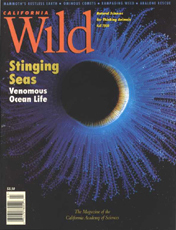|
CURRENT ISSUE
SUBSCRIBE
ABOUT
CALIFORNIA WILD
CONTACT US
ADVERTISING
SEARCH
BACK
ISSUES
CONTRIBUTORS'
GUIDELINES
THIS WEEK
IN
CALIFORNIA WILD
|
Fall 2000
Vol. 53:4

Anemones, coral, jellyfish, and their relatives
are venomous. They possess nematocysts, specialized structures that contain
powerful toxins.
Photograph by
Gary C. Williams.
Departments
Life
on the Edge
The Bad, the Ugly, and the Good
•Keith K. Howell
Horizons
Mapping a Mayan City
•Blake Edgar
Habitats
Seeking Refuge Along the Border
•Gordy Slack
Counterpoints
in Science
Globularization
•Jerold M. Lowenstein
Letters
Guns and Grouse
Worldly Wealth
Yosemite's Bears
Reviews
Rare Earth
Editor's Recommendations
|
Features
Stinging Seas
Tread softly in tropical waters—most venomous creatures live
in the ocean. Some inject toxins directly, while others sting at the slightest
touch.
•Gary C. Williams
Mammoth's
Perilous Magma
Gas seeping from California's Long Valley Caldera makes Mammoth
Mountain a dangerous place.
•Christine Colasurdo
At Home in the
Natural World
Naturalist's Almanac
What to Look for this Fall
•Liese Greensfelder
Skyguide
Christmas Eclipse
•Bing F. Quock
Wild
Lives
American Rain Beetle
•Liese Greensfelder
Not available
online:
Here At The Academy
Library of the Living Dead
•Sally Raikes
Vanuatu Values
Images from the Vanuatu archipelago in Melanesia portray the family
unity that binds communities.
•David Becker
White Abalone Raise the White Flag
California's white abalone have been devastated by overfishing. Can captive
breeding bring them back?
•Catherine Zandonella
Wicked Weed of the West
For 150 years, yellow star-thistle grew unnoticed in northern California.
Now it is the most pervasive weed in the state—and it's not about
to go away.
•David C. Dudley
The Living Sky
Celestial events altered the course of ancient people in the American
Southwest and Hawai'i.
•W. Bruce Masse
|

